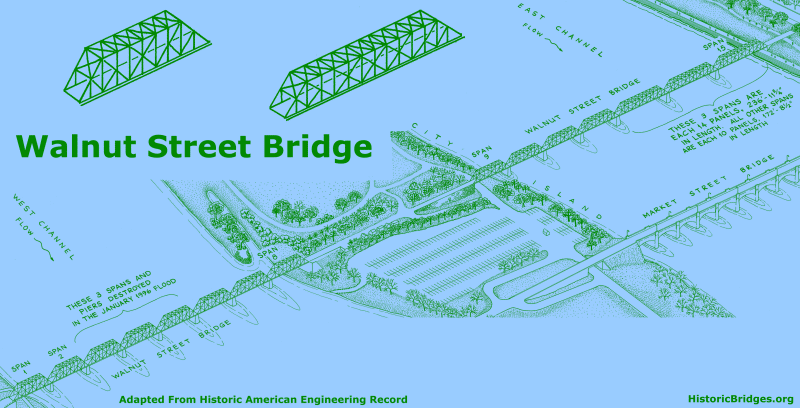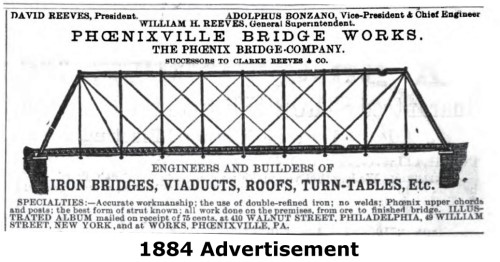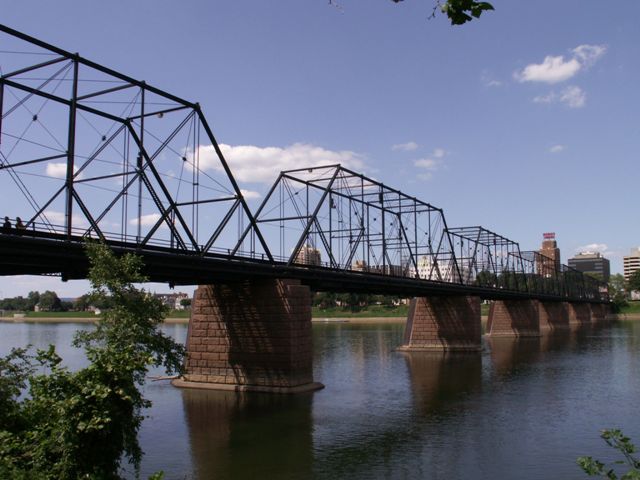We Recommend:
Bach Steel - Experts at historic truss bridge restoration.
BridgeHunter.com Phase 1 is released to the public! - Visit Now
Walnut Street Bridge

Primary Photographer(s): Nathan Holth and Rick McOmber
Bridge Documented: July 10, 2008
Harrisburg: Cumberland County, Pennsylvania and Dauphin County, Pennsylvania: United States
1890 By Builder/Contractor: Phoenix Bridge Company of Phoenixville, Pennsylvania, Dean and Westbrook of New York, New York, Agents and Engineer/Design: Albert Lucius of New York, New York
1996
240.0 Feet (73.2 Meters)
2,820.0 Feet (859.5 Meters)
18 Feet (5.49 Meters)
15 Main Span(s)
Not Applicable

View Information About HSR Ratings
Bridge Documentation
View Historic American Engineering Record (HAER) Documentation For This Bridge
HAER Drawings, PDF - HAER Data Pages, PDF
View The Original Patent For Phoenix Columns
This bridge is the longest known truss bridge remaining that includes the use of the unique (and historically significant) Phoenix columns. As such it is one of the most important historic bridges in the United States. The bridge is listed as a National Historic Civil Engineering Landmark, one of the highest honors bestowed upon a historic bridge in the United States. The bridge has also been listed on the National Register of Historic Places.
The bridge was fabricated by the Phoenix Bridge Company. According to HAER, Westbrook Bridge Company of New York, New York was the contractor for the bridge. If you do a little research however, you can find that their full name was Dean and Westbrook Company. This explains why the railings have D&W imprinted on them.
A testament to the utilitarian value of the pin-connected truss bridge, it took just over a single year to erect the entire Walnut Street Bridge, and the bridge was complete by 1890. Despite less automotive equipment available in the late 19th century, pin-connected truss bridges were often erected much more quickly than modern bridges are constructed today because truss bridges could be fabricated at the factory, shipped to the site, and all that had to be done was to put the pieces together. The bridge was constructed and operated under the ownership of the People's Bridge Company as a toll bridge, until it reverted to PennDOT control in 1954. Between 1893 and 1936 a trolley service also operated on the bridge. Amazingly, remnants of these rails are still visible today poking through the asphalt on the island park between the two sections of the bridge. They are a narrow gauge design.
Unspecified damage occurred to the bridge in 1972 when 15 inches of rain caused by hurricane Agnes fell, causing the Susquehanna River to flood, and vehicular use of the bridge ended. In January 1996, three feet of snow fell on the area, and soon after melted creating a massive flood of ice and debris filled water. Three of the spans on the western half of the bridge were lost in this event. HAER photos show the truss spans did not just get pushed off... indeed the stone pier itself literally was pushed away from its correct location a considerable distance. Photos taken after the storm show one of the stone piers clearly offset from the other piers by many feet, and also leaning. This suggests the incredible pressure that was placed on the piers and bridge. Following this, the eastern half of the bridge which survived intact was rehabilitated for pedestrian use. The western spans remain abandoned and offer a good view of the historic integrity of the bridge prior to this most recent rehab of the eastern spans.
There has been some recent talk and a Peoples Bridge Coalition has even tried to raise money to restore the western spans of the Walnut Street Bridge. This project should include not just rebridging the missing section with a modern bridge, but should include creating replicas of the original spans, including replica Phoenix columns and use of riveting. All of this is possible, as replication of metal historic bridge elements has been accomplished in Michigan and Ohio largely due to the efforts of Vern Mesler. HistoricBridges.org recommends that any project to reopen the western spans include replicating the trusses for the missing spans.
The bridge today retains the level of historic integrity that is to be expected of a bridge dating to 1890 that has been well used (and abused) in an urban environment. There are many parts of the bridge that have been altered and repaired over the years, several of them insensitive to the original design of the bridge. However, given all that the bridge has been through, and given that most of those repairs were made for utilitarian purposes and not historic preservation purposes, the bridge actually is in remarkable condition. The majority of the Phoenix columns and the unusual associated connection details that give the bridge its character and significance remain intact. Most alterations include welds, added materials, and some replaced tension members.
This bridge is tagged with the following special condition(s): Phoenix Columns
![]()
Photo Galleries and Videos: Walnut Street Bridge
Structure Overview
Original / Full Size PhotosA collection of overview photos that show the bridge as a whole and general areas of the bridge. This gallery offers photos in the highest available resolution and file size in a touch-friendly popup viewer.
Alternatively, Browse Without Using Viewer
![]()
Structure Details
Original / Full Size PhotosA collection of detail photos that document the parts, construction, and condition of the bridge. This gallery offers photos in the highest available resolution and file size in a touch-friendly popup viewer.
Alternatively, Browse Without Using Viewer
![]()
Structure Overview
Mobile Optimized PhotosA collection of overview photos that show the bridge as a whole and general areas of the bridge. This gallery features data-friendly, fast-loading photos in a touch-friendly popup viewer.
Alternatively, Browse Without Using Viewer
![]()
Structure Details
Mobile Optimized PhotosA collection of detail photos that document the parts, construction, and condition of the bridge. This gallery features data-friendly, fast-loading photos in a touch-friendly popup viewer.
Alternatively, Browse Without Using Viewer
![]()
Maps and Links: Walnut Street Bridge
Coordinates (Latitude, Longitude):
Search For Additional Bridge Listings:
Bridgehunter.com: View listed bridges within 0.5 miles (0.8 kilometers) of this bridge.
Bridgehunter.com: View listed bridges within 10 miles (16 kilometers) of this bridge.
Additional Maps:
Google Streetview (If Available)
GeoHack (Additional Links and Coordinates)
Apple Maps (Via DuckDuckGo Search)
Apple Maps (Apple devices only)
Android: Open Location In Your Map or GPS App
Flickr Gallery (Find Nearby Photos)
Wikimedia Commons (Find Nearby Photos)
Directions Via Sygic For Android
Directions Via Sygic For iOS and Android Dolphin Browser
USGS National Map (United States Only)
Historical USGS Topo Maps (United States Only)
Historic Aerials (United States Only)
CalTopo Maps (United States Only)







